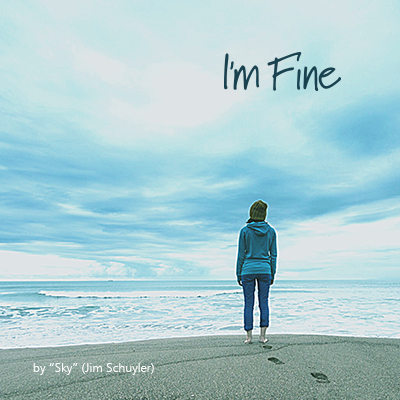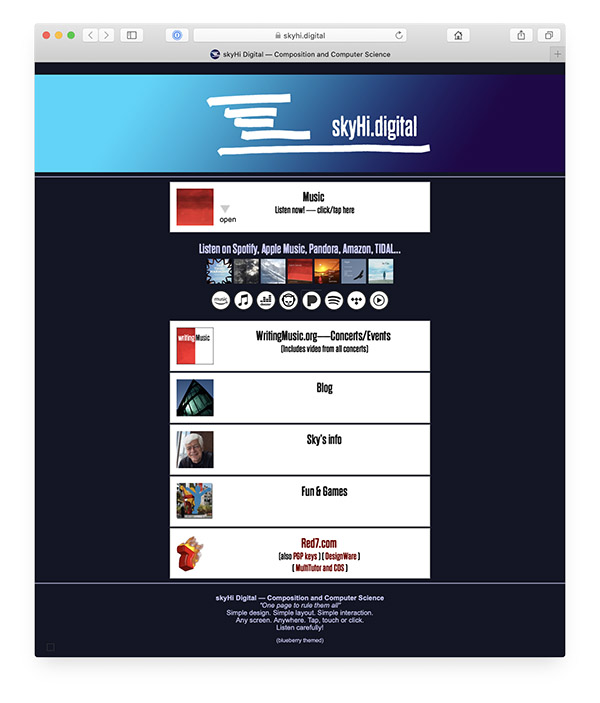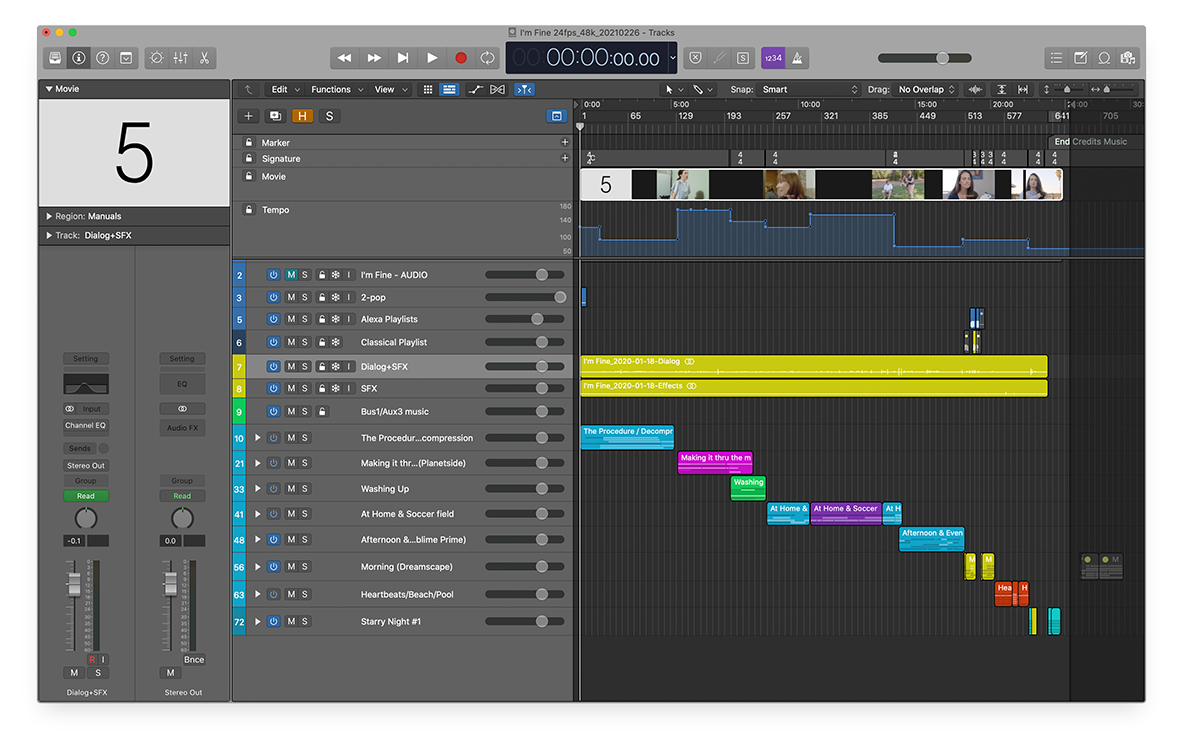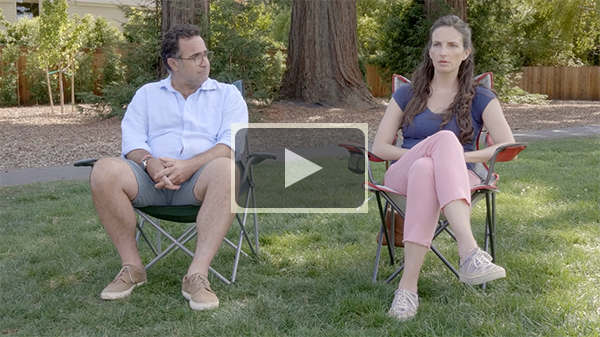The third film I’ve scored was premiered on April 2nd, 2021. The film is entitled I’m Fine, and was produced by Kip Pearson and directed by Andrea Devaux.
My first two films were Indulgence (Leo Maselli) and The Third Harmony (Michael Nagler).
For those of you not familiar with how a composer creates music for a film, I thought I’d go thru how Kip and I collaborated to put music to this story.

Scoring the Film — How we Started
Kip and I had a chat about music for her film months before anything was shot. Late in 2020, the shots were all “in the can“ (with COVID protocols on the set) and Kip gave me an early rough cut of the then 24-minute film. The editor, Charles Anderson, had done an excellent job cutting and assembling the scenes, and honestly there was very little that changed in terms of scene lengths between then and the final version. At this early stage the final colors weren’t set — the film looked somewhat grayish — and the dialog was basically unedited, requiring selection from among multiple microphones, and sometimes a bit of sonic cleaning up. But the sequence of shots was close to final in this case, and the story line was clear. (Not every filmmaker works this way.)
 At any given time I have dozens of songs or musical ideas just waiting to be used in films. So I pointed Kip at my online music bin and said “Listen to everything — at least the first 20 seconds of each — and then let me know what pieces of music you feel might work in the film. Based on her suggestions, I then refined (and added) what I thought might work, but mostly we worked from her selections.
At any given time I have dozens of songs or musical ideas just waiting to be used in films. So I pointed Kip at my online music bin and said “Listen to everything — at least the first 20 seconds of each — and then let me know what pieces of music you feel might work in the film. Based on her suggestions, I then refined (and added) what I thought might work, but mostly we worked from her selections.
Interestingly, a large percentage of what she liked had already been used in films. This is actually no problem, because it helps me understand what she was reacting to.
I then took a set of about eight of these and positioned them within the rough-cut film, so we could review the film with dialog and with my suggested music.
Making the Music Fit the Film
My digital audio workstation [DAW] is the Logic Pro X app (from Apple), which allows me to view the film second by second, and directly position the music against each cue in the film.
 In the screen shot above, the film runs left to right on the timeline, and below it are the various pieces of music looking like a colorful waterfall. Each is positioned where it’s going to go time wise in the film. The goldenrod colored bars are the sound effects and the dialog of the film, which run its entire length.
In the screen shot above, the film runs left to right on the timeline, and below it are the various pieces of music looking like a colorful waterfall. Each is positioned where it’s going to go time wise in the film. The goldenrod colored bars are the sound effects and the dialog of the film, which run its entire length.
Wherever music needed to be stretched, I just wrote more music — basically I had all of the instruments available to me there in real time and I just write and tailored the music to each scene. A couple of pieces of music I adapted to be shorter. As composer, of course, I have complete flexibility to do anything I want to the music, and I do not have to worry about whether Beethoven or Mozart would complain. I just make whatever changes I wish to make.
The 25-minute film ended up having 10 music cues by the time we finished. Very little silence, and honestly almost wall-to-wall music. In some films I add “designed sound” to scenes, but in this one we remained melodic and instrumental instead.
The “Alexa” Segments
Most of the music in the film is “movie music” — the kind you’re used to from many films. But, also for this film we needed three very short (10-second) pieces of diegetic music. Diegetic means it’s part of the action in the scene. In this case our heroine asks Alexa to play some music. We needed 80’s pop, classical, and jazz. Rather than license from someone, I wrote the jazz, asked another SFCM composer (David Tippie) to write an 80’s pop soundalike, and paraphrased Erik Satie for the classical (out of copyright) segments.
So What’s New?
This is the first time any of this music has appeared in any film or album.
Only one piece of music was written specifically for this film. Everything else was waiting for the right time and the right film. All of them were written in the last 3 years.
Once the entire arc of the music for the film was completed, and after a small number of revision rounds, we were set to go. For this film, I provided the sound mixer with three “stems.” These are audio files that run the entire length of the film; in parallel; and the volume of each can be adjusted based on what’s needed at any instant. In this case, I provided a finished “mix” with all of the instruments at the volumes I felt were best at every second in the film; but I also provided a full-length file consisting of the music without any drums; and finally a full-length file with only the drums. It’s the job of the film’s sound mixer to use these along with dialog and sound effects to make the finished audio for the film. I get to listen to it and comment, but I don’t play a direct role in its construction once I’ve turned over the stems.
The Trailer
 The one original “song” was the most emotive and wrought-up of the group, and it fit the mood of the trailer perfectly. (Charles Anderson, the film’s editor, did a terrific job piecing together that trailer) The music was actually significantly longer than the trailer, so much as I did for the film, I placed the trailer visual in my DAW and then stripped and recomposed to get the effect I wanted for the trailer. I could literally work down to the precise frame in the video. The drummer in the trailer actually is a different drummer than was used in the film…for emphasis…I love those huge taiko drums and so that’s what I wanted at the end of the trailer. In the film itself there’s some quasi-taiko drumming, but not quite that much.
The one original “song” was the most emotive and wrought-up of the group, and it fit the mood of the trailer perfectly. (Charles Anderson, the film’s editor, did a terrific job piecing together that trailer) The music was actually significantly longer than the trailer, so much as I did for the film, I placed the trailer visual in my DAW and then stripped and recomposed to get the effect I wanted for the trailer. I could literally work down to the precise frame in the video. The drummer in the trailer actually is a different drummer than was used in the film…for emphasis…I love those huge taiko drums and so that’s what I wanted at the end of the trailer. In the film itself there’s some quasi-taiko drumming, but not quite that much.
The Album
 After the film was fully locked and music was mixed, I took the music itself, which spanned the 25 minutes of the film, and created a new project in my DAW just for the audio. The film had scenes with no music, so I expanded the music to be end-to-end 25 minutes, by adding and extending some of the selections. I also created a broader sonic spectrum and changed some of the instruments. Music sounds different when standing on its own (that is, when “supporting” action and dialog). This somewhat richer version of the soundtrack then becomes the Original Motion Picture Soundtrack album. This goes into the queue at CDBaby for distribution to all of the streaming services. Once it’s distributed, it can be played or downloaded online. SkyHi Digital has a page with links to the album on the various streams.
After the film was fully locked and music was mixed, I took the music itself, which spanned the 25 minutes of the film, and created a new project in my DAW just for the audio. The film had scenes with no music, so I expanded the music to be end-to-end 25 minutes, by adding and extending some of the selections. I also created a broader sonic spectrum and changed some of the instruments. Music sounds different when standing on its own (that is, when “supporting” action and dialog). This somewhat richer version of the soundtrack then becomes the Original Motion Picture Soundtrack album. This goes into the queue at CDBaby for distribution to all of the streaming services. Once it’s distributed, it can be played or downloaded online. SkyHi Digital has a page with links to the album on the various streams.
The interaction with the film’s producer, and the film and sound editors, was very good. Feedback usually makes huge improvements. It’s good to have many ears listening to the music when it’s being refined. Collaboration works wonders.
Thanks for the great explanation of how the music was created, Sky. As I watched this moving film I wondered how you worked with the film crew to coordinate the music with the scenes. Now I know. It’s great to see your creativity unfold in the world of film, Sky. Congrats!